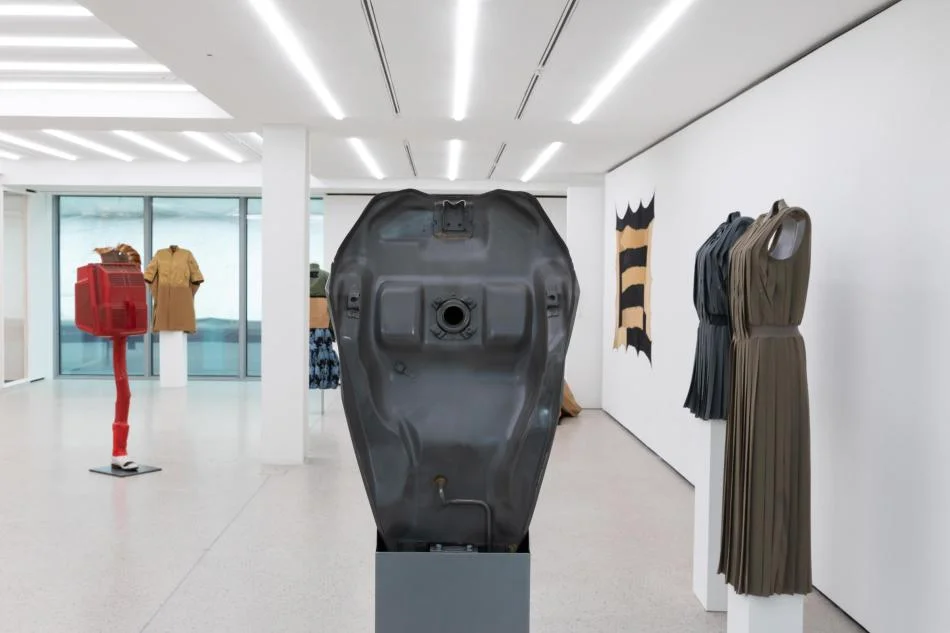La pensée corps
The exhibition La pensée corps brings together the work of Alexandra Bircken and Lutz Huelle, both of whom are linked to questions of identity, intimacy, permeability and vulnerability of the human being. What links them is a style with forms that are alternately fractured and assembled, cut and sutured, and a long history of friendship.
This exhibition is not about the relationship between art and fashion, even though it is a natural one. The focus is on the mechanisms, the gestures, the thinking of the contemporary body and our experience of it as human beings. Both sectionalise and fractionalise objects and clothes as adjustable models for new ways of living, feeling and representing.
This essential relationship to the body and materials was affirmed for Bircken and Huelle during their design studies at Central Saint Martins College of Art and Design in London in the 1990s. There they were able to project their ideas onto the body as a medium. During their apprenticeship at this prestigious school, individuals such as John Galliano, Alexander McQueen and Hussein Chalayan were regularly invited for talks. This period led them to define their own identity by re-inventing themselves as one wishes to do at 20. It was also their taste for music, Culture Club and Boy George among other queer personalities, that made them choose London.
Friends since their teens, they soon formed an elective family with a third accomplice, the German photographer Wolfgang Tillmans, author of cult portraits of Bircken and Huelle. An objective witness to a whole generation, he has vigorously challenged preconceptions, contributing to the emergence of a certain truth about youth, from the mid-1990s to the present day. All three reflect their time, politically and sociologically, and shake up archetypes. For La pensée corps, Wolfgang Tillmans presents a chapter he made for Pop Magazine (2019-2020) dedicated to Lutz Huelle. This is a very valuable piece as it allows us to approach a lot of details about Huelle’s work, as well as being a witness to the relationship of the trio through the years.
Alexandra Bircken first created her own brand, at a time when Martin Margiela and Comme des Garçons were deconstructing clothing. It was by sewing, knitting and making non-functional objects for herself that she gradually entered the territory of art. Jörn Bötnagel and Yvonne Quirmbach, founders of the BQ gallery in Cologne, now based in Berlin, were assiduously observing their neighbour in a studio adjoining the gallery. Attentive to the freedom with which the self-taught artist explored the possibilities, they offered her her first exhibition at the gallery in 2004.
Lutz Huelle first worked for the Antwerp designer Martin Margiela, before launching his own label in 2000 with his partner David Ballu. He quickly turned his attention to constructing clothes through deconstruction, developing an asexual style. For a long time, Bircken, with his androgynous and haughty appearance, was the model of choice for Huelle’s shows. What he proposes to women and men is to wear clothes that do not force them to define themselves, nor to constrain themselves to a model.
This form of deconstructivism is omnipresent in Alexandra Bircken’s work. In her work, this relationship to the body, to gender and to materials translates into a powerful and direct plasticity. Her works reveal the functioning of a thing, its intimacy, its construction or its assembly, whether it is a garment, an organ, a body fragment, a motorbike or a gun. Her experiments with materials also reveal his interest in the skin as an organ, a garment, a cellular structure, a vulnerable boundary between inside and outside.
For Lutz Huelle, fashion is a language. His clothes deconstruct archetypes and highlight mutations through hybrids: half coat-half bomber, a man’s tuxedo jacket with ultra-feminine red fringes, half boxing trousers half skirt, a sexy shirt with a dinner jacket collar.
If the contemporary body is often thought of in binary terms, masculine or feminine, martial or vulnerable, powerful or fragile, Bircken and Huelle propose representations that implode them. When they experiment with weaving, braiding, knotting or cutting, they adopt an anthropological approach, which evokes their taste for ingenuity and the multiplicity of inventions and uses those human beings have developed since the origins to clothe and protect themselves.
Their generation (mine too) was the one that was twenty years old when the Berlin Wall fell, and Europe was built. Their productions do not have the same purpose, nor do the processes that shaped them, but they share a similar aesthetic. They have listened to the same music, observed the evolution of the world and thought about the vulnerability of the body and its repair. For him and her, the street remains a major place of inspiration where they observe and draw elements that are then injected into the folds of their work.
Claire Le Restif
Curator of the exhibition
Photo : (c) Léa Guintrand
